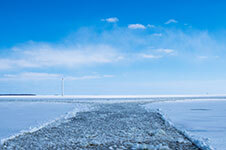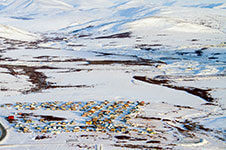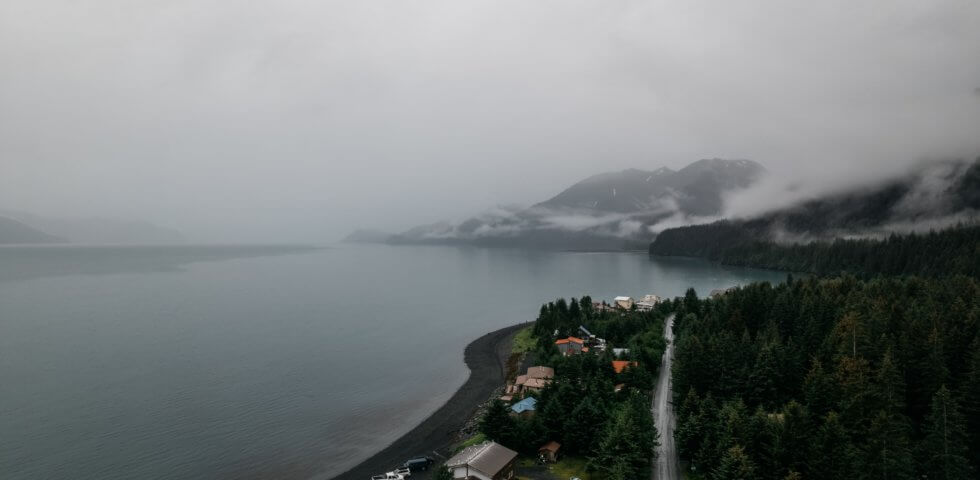Rural Alaska takes up a great portion of the state, housing approximately 150 communities and more than 60,000 residents. Stretching from the Bristol Bay area to the North Slope oil fields, the Alaskan Arctic contains a diverse set of landscapes, unparalleled in their natural beauty. However, a stunted economy, few educational opportunities, and a general lack of infrastructure make daily life difficult for residents of rural communities, causing a clear divide between rural and urban areas of Alaska.
At the core of this disparity is a severe lack of technological resources in the Arctic. Reliable, fast internet has historically been difficult to access in rural Alaska, and the few options available were extremely expensive. However, with climate change taking its toll and the reduction of Arctic sea ice, there is now the opportunity to better serve these communities.
Quintillion seized this opportunity as true pioneers in the world of telecommunication. We’ve taken on the mission to not just bring better, more affordable broadband service to rural Alaska but to connect the North American Arctic to the rest of the world. It may seem like a lofty goal, but we’ve already taken leaps and strides toward making it a reality.
Quintillion has achieved what no one else has: We built the first and only North American Arctic submarine and terrestrial fiber optic cable network.
Want to learn more? Connect with us here.
The Quintillion Fiber Optic Cable Network
The Quintillion network consists of fiber optic cable that spans 1,700 miles across the Alaskan Arctic. This includes 1,200 miles of subsea fiber cable from Nome to Prudhoe Bay, which is buried 12 feet below the seabed, and 500 miles of terrestrial fiber cable that spans from Prudhoe Bay to Fairbanks, running parallel to the Trans Alaska Pipeline System.
The network connects to six cable landings which are each installed 60 to 80 feet below the ocean floor in steel conduits with branching units located up to a mile offshore. Their design includes a trunk and branch configuration to provide redundancy and reduce latency. The system runs off robust power feeds and redundant equipment at each landing station, which each features 24/7 monitoring and response. The three-pair system has a 30 TeraBytes per second capacity, which is scalable up to 90 TeraBytes per second.
Alaska’s Leading Provider of Broadband Network
Quintillion is not an internet provider, meaning we do not deliver internet straight to end-users. Rather, we’ve built the infrastructure and provide middle-mile backhaul services to last-mile service providers (or internet service providers) who in turn provide the fastest, most resilient broadband services/products to their customers.
Here’s a more technical breakdown of our services:
- We are a provider of carrier ethernet services — Carrier Ethernet service is a data communications service based on Ethernet technology and standards, with additional features and protocols that enable “Carrier Grade” telecommunication services to be securely and reliably managed and delivered to customers. Carrier Ethernet service delivers Ethernet frames between different locations in any part of the world at speeds between 1 Mbps and 100 Gbps.
- We provide carrier ethernet E-line service — Transit E-Line services enable point-to-point (EPL) or point-to-multipoint (EVPL) connectivity between customer locations. Extension beyond our networks is possible to extend services over multiple provider networks.
- We provide dedicated internet access (DIA) — Dedicated Internet access (DIA) is a private connection between an Internet Service Provider (ISP) and the customer’s premises; the bandwidth purchases by the customer are for their sole use and there are no other users sharing the customer’s connection speed.
Our broadband service helps fill in gaps for internet and telecommunication services in the Arctic, providing reliable, fast, and cost-effective broadband to residents in the Alaska markets of Nome, Kotzebue, Point Hope, Wainwright, Utqiaġvik, and Prudhoe Bay.
Our fiber optic cable network connects these rural communities with the rest of Alaska, Seattle, and Portland by integrating with existing networks that reach these areas. But we don’t plan to stop there. We’ve already mapped out where we plan to go next.
In the phases of the Quintillion project, we plan to extend our subsea fiber cable network from Nome to Japan. Next, we will lay new fiber starting from Prudhoe Bay, Alaska to Canada and then into Europe. The final step is to construct a low latency route spanning from London to Tokyo.
How the Quintillion Network Is Supporting Alaska’s Community
In a world that runs on technology, access to secure internet is considered by some to be a basic necessity — and even more so following the pandemic. In many parts of the world, people are becoming dependent on the internet to shop for food, advance their education, access emergency services, maintain social relationships, and to find work. Not having access to reliable internet can bar people, and entire communities, from advancing their economic status and accessing things like healthcare, remote work, and online school.
For Arctic Alaska, widespread difficulty accessing the internet doesn’t just affect individuals — it’s disadvantaged entire communities. Advanced technology plays a significant role in allowing local governments to communicate with residents and employ public safety measures in a crisis. In addition, a digital divide hinders productivity in the workforce and adds barriers to accessing valuable resources for public libraries and educational institutions.
Quintillion’s fiber optic cable network is one giant step in helping communities in rural Alaska bridge the digital divide and utilize the benefits of fast, reliable internet. This includes:
- Boosting the economy through IT-driven processes like financial transactions, remote work, online hiring platforms, ecommerce, and supply chain management.
- Building advanced educational infrastructures, implementing remote learning, and more for both K-12 and higher education.
- Increasing access to healthcare and mental health services through online platforms, telemedicine, and additional remote health services.
- Enhancing public safety communications through accessible emergency services, improved access to crisis resources, highway monitoring systems, and more.
- Advancing communication and technology for remote Alaskan industries, including mining and oil and gas.
- Supporting national security measures by enabling advanced crisis communication methods and providing localized edge computing and cloud services.
Quintillion’s Alaskan Community Partners
Quintillion’s main goal is to better improve service to Alaska’s more underserved communities. And we know that connecting rural Alaska with the rest of the world is essential for helping residents to continue living in remote areas. To make this goal a reality, we’ve partnered with several Alaska Native corporations, local government entities, locally based services providers, and corporate clients to continue advancing the least-accessible parts of the state.
We strive to continue fostering strong relationships with the Alaskan community and placing the needs of its residents first. While we’re proud to say our growth is being funded from within (since 2018, we’ve been able to fund Quintillion’s growth with cash flow from operations without requiring any additional investments), we are thankful to our partners for enabling us to make an impact in communities we all care for.
Our pioneering spirit leaves us looking ahead as we work toward building our network further, connecting the Alaskan Arctic to Asia, Canada, Europe, and beyond. We are also in the final steps of planning a state-of-the-art data center for residents, oil and gas operators, environmental monitoring firm, and the Department of Defense.
Excited for what’s in store? We’d love to hear about it. Contact us here.















